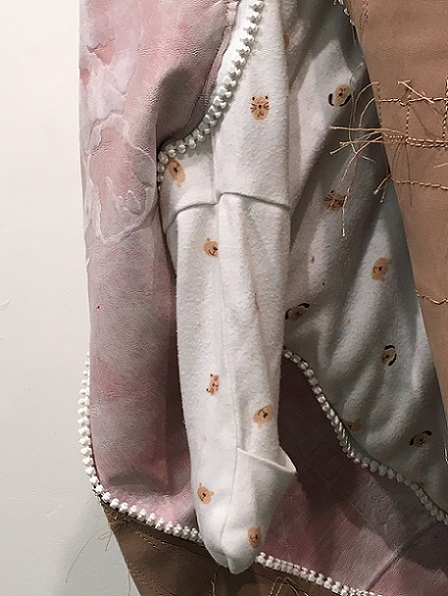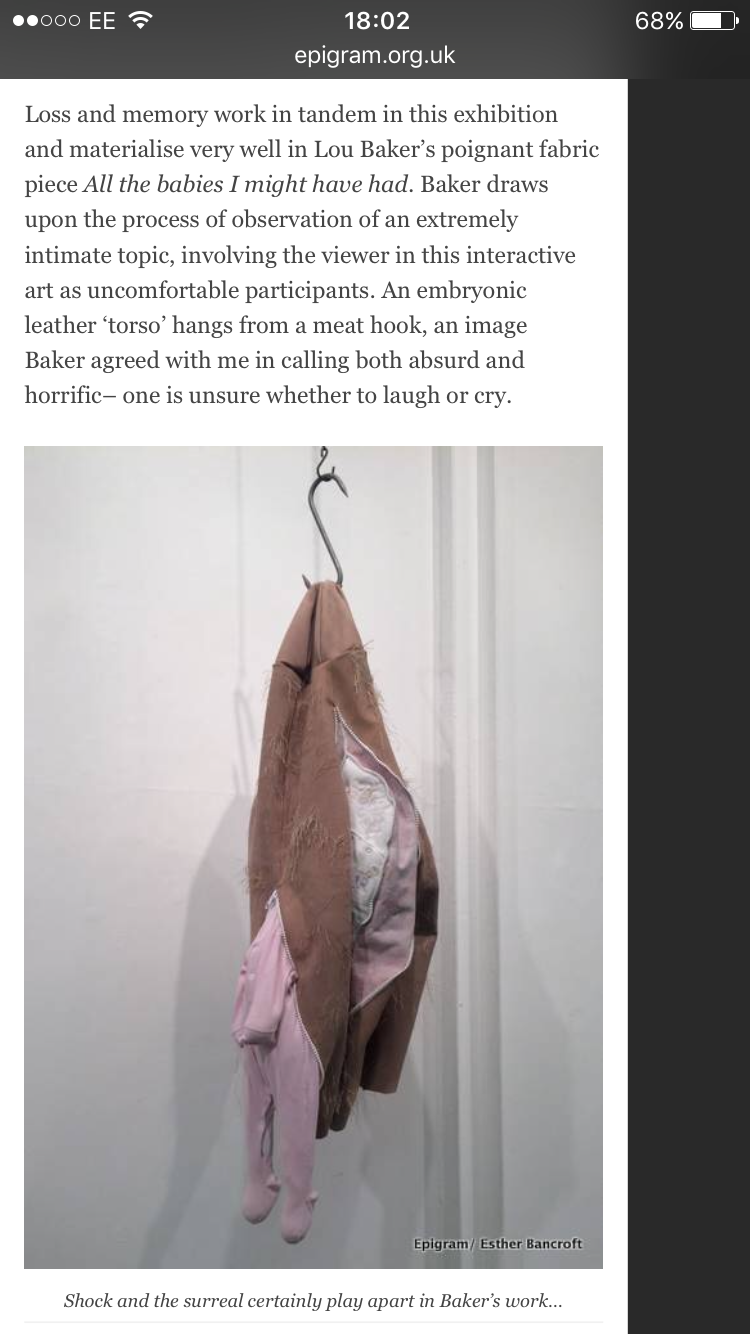* For details of my stitched work, please scroll down*
Stitch
Communication
Meaning
Provocation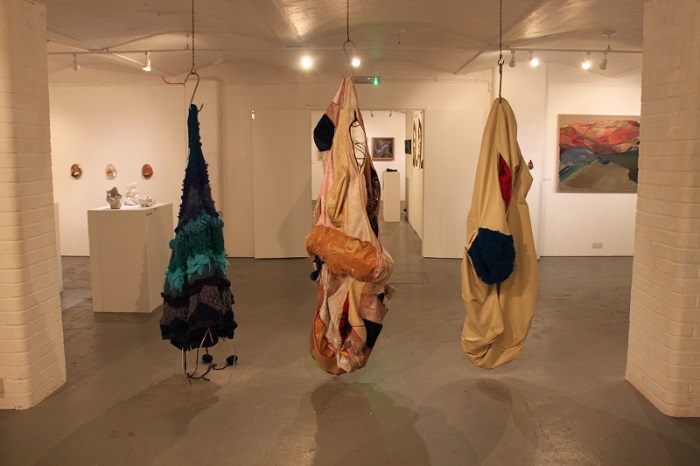
Nobodies, 2015, leather, imitation leather, used clothing, hair, knitting, felted hand knitting, paint, zips; stitch, print. Installed at Synecdoche, Embassy Tea Gallery, London, July
Subversion
The dark side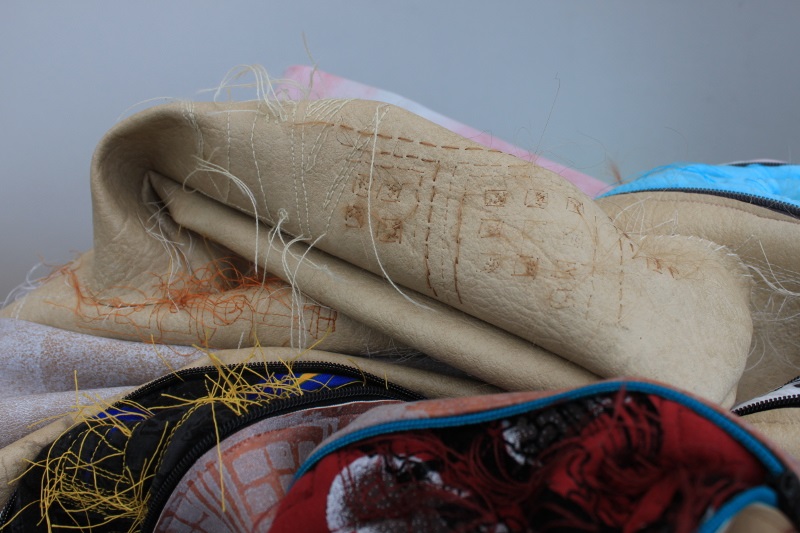
Nobody 1, 2014, detail, leather, imitation leather, used clothing, hair, paint, zips; stitch, print
Mark making
Drawing
Gestural
‘Sloppy craft’
Loose threads
All the babies I might have had II, 2015,
leather, imitation leather, used clothing, felted hand knitting, zips; stitch, print. Installed at The Knitting and Stitching Show, London, October
Line
Form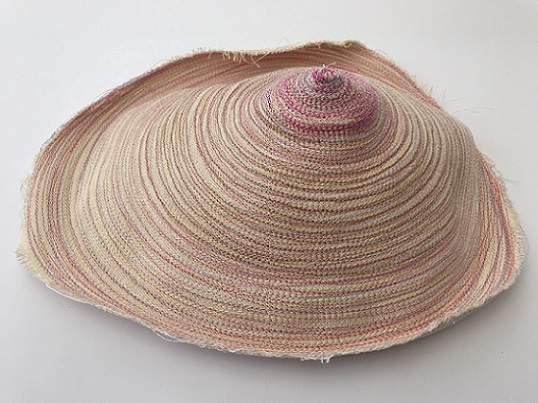
The whole is greater than the sum of the parts, 2018, detail, canvas; stitch
Colour
Surface
The whole is greater than the sum of the parts, 2018, canvas; stitch. Installed at Subversive Surfaces, Town Hall Arts, Trowbridge, June/July
Tactile
Blurring the senses
Haptic/scopic
Sculpting
The others; a self portrait, 2015, leather, imitation leather, knitting, felt, felted hand knitting, velvet, fake fur, zips; stitch. Installed at The Degree Show, UWE, Bower Ashton campus, Bristol, July
Connecting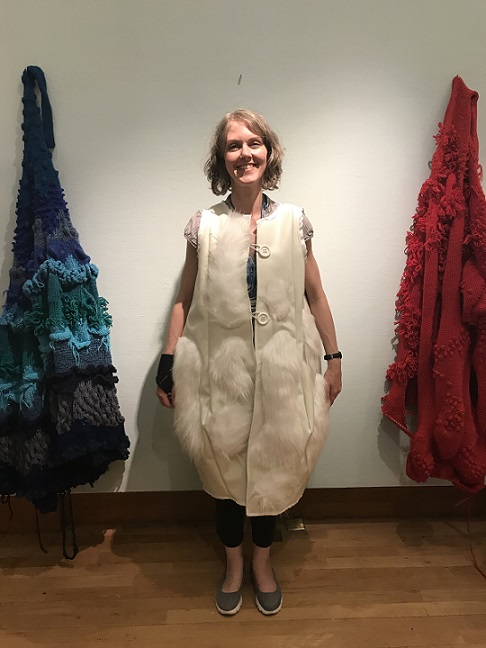
Living sculpture; white, 2018, imitation leather, fake fur, buttons. Worn by a participant at Living sculptures, Make space, Bristol Museum and Art Gallery, July
Construction
Garment making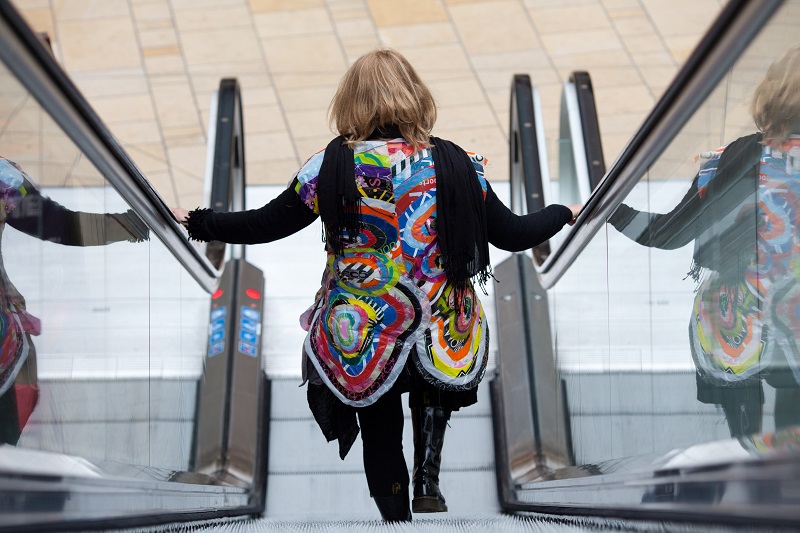
Plastic surgery, wearing the unwearable, 2012, plastic bags; stitch. Performance still, Cabot Circus, Bristol
Embroidery
Quilting
Patchwork
My imaginary friend, 2012, used clothing, velvet, zips
Drapes and folds
Hiddenness
Revealing and concealing
Layers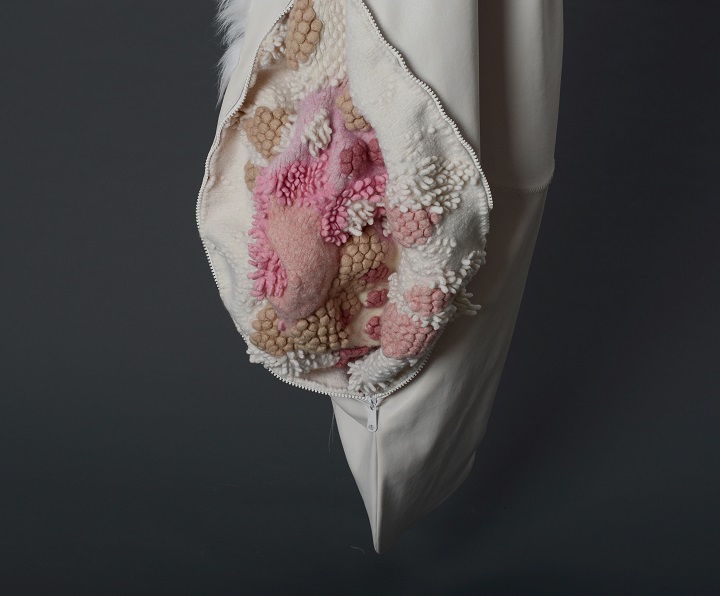
Other 1, 2015, detail, imitation leather, felted hand knitting, fake fur, zip; stitch
Thinking
Conceptual
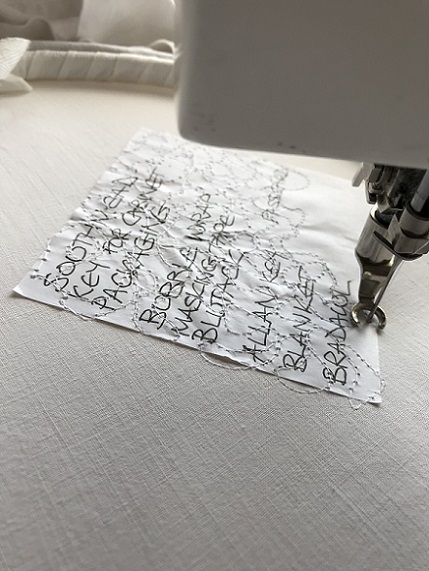
Tethering my thoughts, 2018, lists, pillowcase; stitch
Embroiderers' Guild scholar
Transformation
Alchemy
Led by materials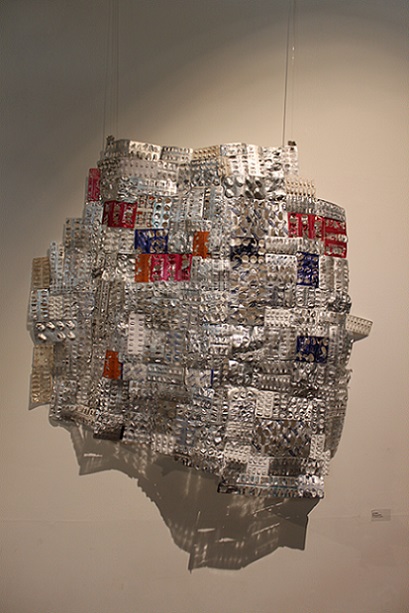
Pharmacopoeia, 2017, pill packets, staples. Installed at Subversive Surfaces, Town Hall Arts, Trowbridge, June/July 2018
Manipulation
Piercing
Tattoo
Materiality

Nobody 1, 2014, detail,leather, imitation leather, used clothing, hair, paint, zips; stitch, print
Physicality
Second skin
Therapy
Meditation
Happiness
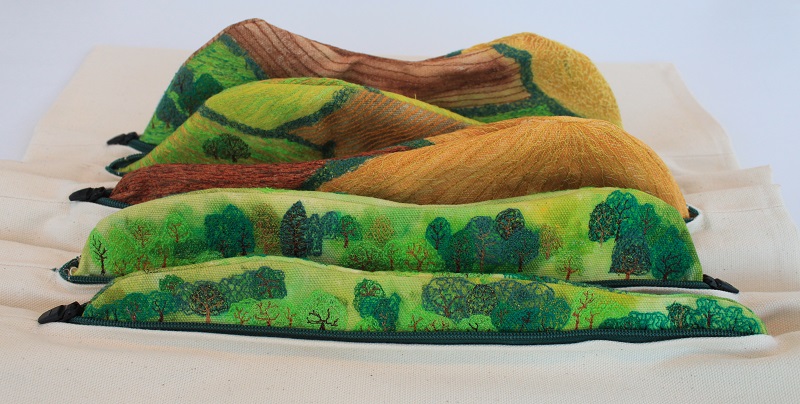
Over the hills and far away, 2012, artist's book, canvas, zips; stitch
The dark side of stitch
'Attraction and repulsion, horror and hilarity; creating an uneasy tension in aesthetics by challenging the seemingly benign nature of traditional textile processes, Lou Baker’s life-sized soft sculptures provoke a range of conflicting responses. Using cloth and stitch as a vehicle for meaning, her investigations into the transformation of materials and the sculptural and mark-making potential of stitch subvert conventional representations of the body, forging intellectual connections between material, process and concept. 
All the babies I might have had II, 2015, detail,
leather, hand knitted felt, used baby clothes, zips; stitch, print
Visually pleasing with an uncanny bodily presence, these troubling forms explore individuation, a process which, according to Carl Jung, needs to occur in the second half of life, of finding meaning in life. It is ultimately a preparation for death. Jung talks about balancing our multiple selves with the dark side, or shadow, of ourselves and maintains that failure to acknowledge and accept this shadow can result in fragmentation and associated mental health issues. He also describes the shadow as being the seat of creativity, and creativity is linked to happiness. 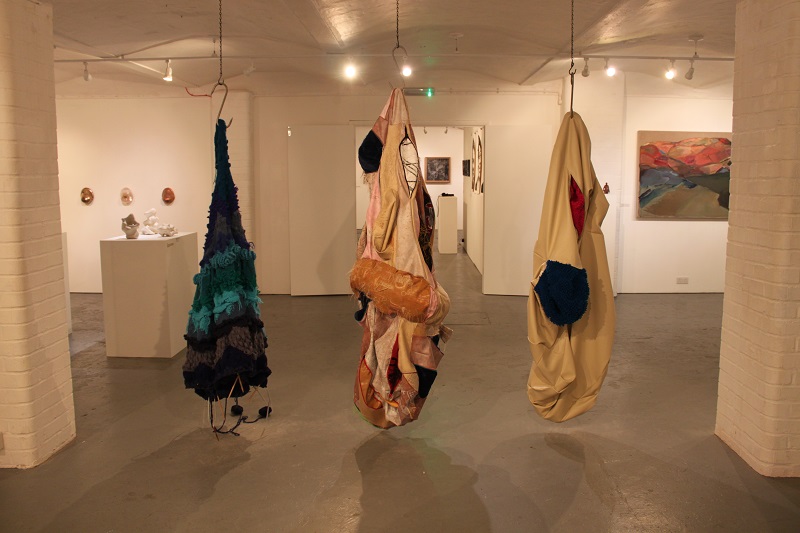
Nobodies, 2014, installed at Synecdoche, Embassy Tea Gallery, London, June, hand knitted wool, imitation leather, leather, velvet, used clothing, hair, hand knitted felt; stitch, print
Baker regards her work as a form of self-portrait, a reflective and emotive response to the ongoing excavations of her dark side, an embodiment of a mid-life crisis, with an undercurrent of dark humour. The change in control brought about by processes of alchemy underpins her investigations into the dialogue between personal memories and universal themes. She makes public things that are normally private.
For her, making is meditation; many of the techniques she uses are labour intensive and repetitive, inducing a state of meditative timelessness which creates a profound sense of well-being. The psychologist, Mihaly Csikszentmihalyi, calls this the state of flow, which, he maintains, is also linked to happiness.
Baker’s work interrogates the stereotypical, gendered expectations of work with textiles in many ways. Cloth itself is regarded as a gendered material; Roszika Parker, in her book, The Subversive Stitch, analyses the gender divide between ‘high’ art and feminised craft and proposes that cloth is a signifier of the private, and thus feminine, sphere. The critical theorists, Julia Kristeva and Mary Douglas, suggest that there are also femininities associated with discarded clothing, hair and recycled imitation leather linked to dirt, contamination anxiety and the abject which add meaning to Baker’s choice of materials.
Cloth as an unconventional medium in sculpture also adds to the meaning it conveys. Traditionally, hard, durable materials like stone, marble and bronze have been used; the soft, impermanent nature of cloth, however, evokes the human form and its mortality. 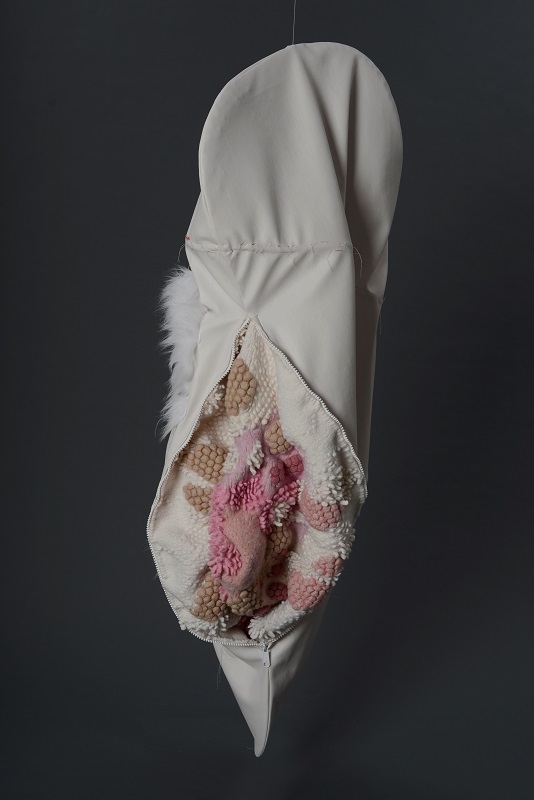
Other 4, 2015, detail, imitation leather, fake fur, zip; stitch
There is a merging of the senses of touch and sight associated with cloth as well. Using a range of traditional textile processes, Baker creates poignant skin-like surfaces which blur the visual/tactile divide. Cloth can also be regarded as an extension of the body, a second skin.
Nobody I, 2014, detail, imitation leather, leather, velvet, hair, used clothing; stitch, print
As a former Embroiderers’ Guild Scholar, a high level of skill in her work is important to her, as is the rich tradition of embroidered textiles. However, at times, she feels that her stitched work needs to be ‘sloppy craft’, rougher, gestural and emotive, in order to communicate a range of alternative meanings and leave clear evidence of her making. Blurring the boundaries between craft and fine art, her work excavates the possibilities of there being a dark side to the perceived notions of knitting and embroidery as gendered, decorative, safe, clean, perfect and private pursuits.'
For further reflections on stitch read my blog posts The dark side of stitch, Cloth and the abject, Giant genitalia; in defence of the zip and my Embroiderers' Guild Scholar's report.
For more images and details of my stitched work, please scroll down.
Gallery of stitched work:
1. All the babies I might have had II, 2015, leather, baby grows, zips; stitch, print
2. Displacement activity #9: Sculpting with pill packets and a stapler, September 2017
3. The Others; a self portrait, 2015, installed at The Degree Show, UWE, June
4. Nobodies, 2014, installed at Synecdoche, Embassy Tea Gallery, London, July 2014
5. Nobody 1, 2014, imitation leather, leather, velvet, used clothing, zips, hair, acrylic paint; stitch, print; 190 x 70 x 70 cm, 5.5kg approx., floor installation
6. Nobody 1, detail
7. Nobody 1, detail
8. Nobody 1, detail
9. Nobody 2, 2014, detail, hand knitted felt, zips; stitch; 175 x 40 x 60cm
10. Cosy series, triptych, 2014, cloth, stitch
11. Seascape, 2010, detail, stitch on canvas
12.My imaginary friend, 2010, installation, used clothing, zips;stitch
13. No animals have been harmed in the making of this garment, 2011, fake fur, cuddly toys; stitch, 150 x 100 x 60cm
14. The parts I'd like to remove, 2010, canvas, fabric samples, maps, anatomy textbook pages, zip; stitch
15. False memory # 1, 2014, velvet, beanie bottom; stitch
16. Beanie baby, 2012, side view, baby grow; stitch
17. Articulated hand, 2012, canvas; stitch
18. Horizon, 2011, acrylic and stitch on paper, reversed, installation view
19. Over the hills and far away, 2011, artist's book, canvas, acrylic, zips, ribbon; stitch
20. Plastic surgery, 2012, plastic bags, stitch, performance still
21. Pod of wonder, 2014, detail, imitation leather, velvet, quilted and stitched drawing, zips
22. Seascape triptych, 2012, detail, acrylic and stitch on canvas
23. Tethering my thoughts, 2018, work in progress, lists, pillowcase, stitch
July 2018, Living sculpture (white & furry), imitation leather, fake fur, buttons
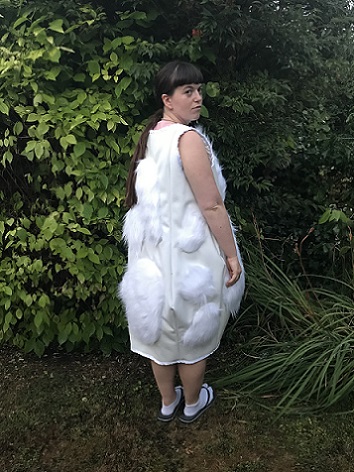
I have had the idea of making a selection of garment-like, wearable soft sculptures for a while now. I wanted to offer visitors the opportunity to become active participants by inviting them to not only touch, but to wear these sculptures. In 2018 I had a proposal to this effect accepted. I set up Living sculptures, a participatory installation, for one day in July at Bristol Museum and Art Gallery’s Make Space, a room alongside The Woman’s Hour Crafts Prize exhibition.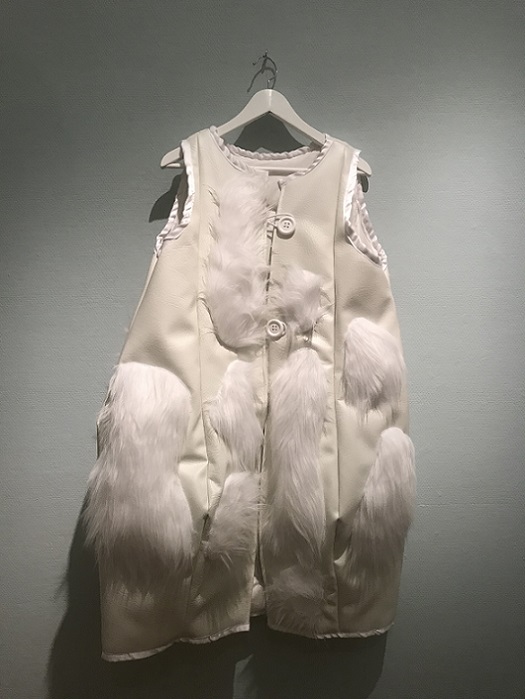
Identity is often communicated through the clothes we wear, but, at a deeper level, the multiple selves we reveal to the world can conceal our true sense of self. Living sculptures investigates this disconnect. For more details of this event please have a look at my Exhibitions page and for details of the interactive aspects have a look at my Participatory art and social engagement page.
One of the sculptures I made for that event was Living sculpture (white & furry). It’s made out of white imitation leather and has sculptural, stuffed patches of fake fur stitched to it. Because of the rigidity of the imitation leather, it has a quirky bell-like shape. I added 2 large white buttons as closures.
It’s probably the most easily wearable Living sculpture so far. It almost looks as if it could be an actual article of clothing, albeit rather an eccentric one! I think, for this reason, I like it least! It’s not weird enough. However, it’s only had one day’s outing so far, and maybe, as one of a multitude of wearable sculptures it would work better. Maybe though, for some people it would be easier to try on as it’s not so odd!
I did enjoy the way that it made people move in interesting ways, though! One of my models was compelled to strike a range of classic modelling poses.....
....whilst participants at Make Space posed, danced and rocked!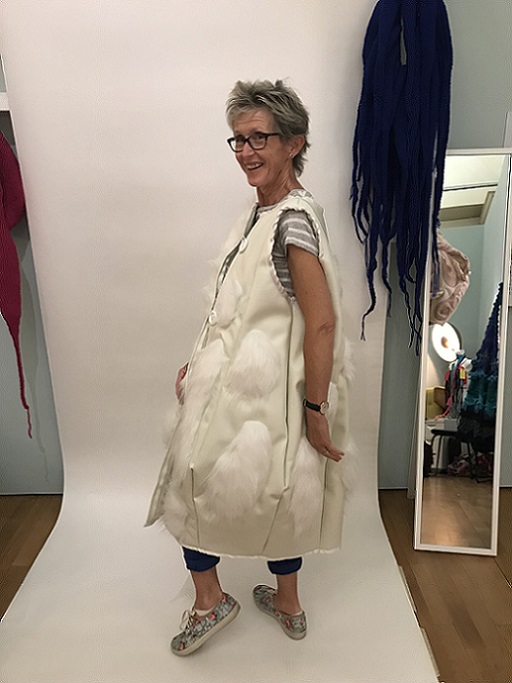
It was an interesting challenge to make sculptures that could be put on and worn by anyone and everyone, in terms of age, size and ability. I haven’t yet had the chance to see how a child would cope, but I hope to find out at some point.
Have a look at the full documentation of the research I have done with my Living sculptures, by clicking on the image below. It includes a week trialing Living sculptures at disquiet, Walcot Chapel, Bath in September 2018. Living sculpture, white & furry didn’t feature during that week, but my knitted Living sculptures did!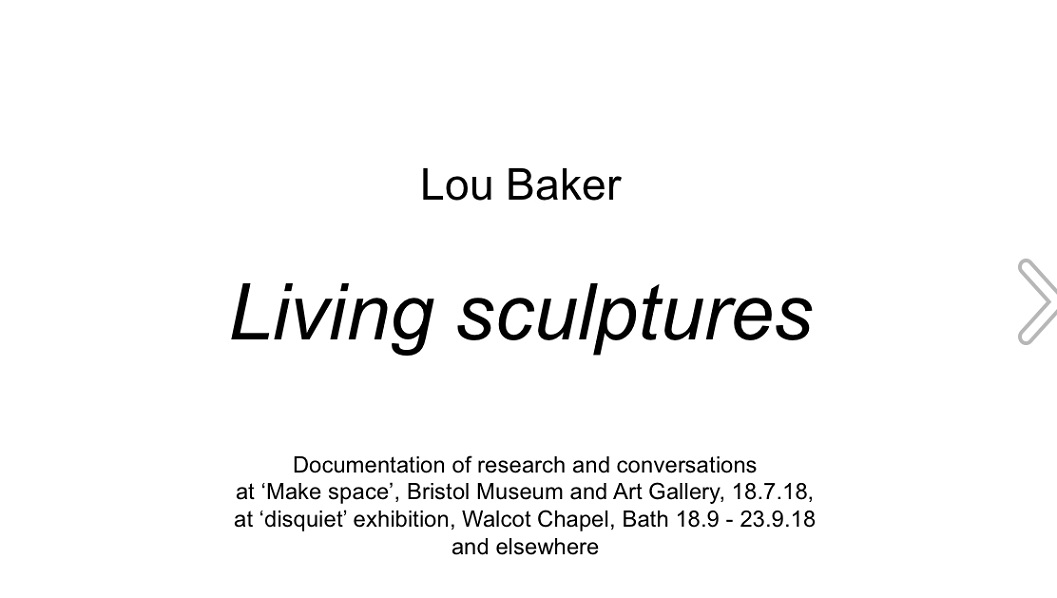
And here are some more images:
May 2018, The whole is greater than the sum of the parts, canvas, intensive stitching

The whole is greater than the sum of the parts is a hanging, stitched soft sculpture. Constructed as a quilted patchwork of abstract body parts, intensely embroidered with a selection of skin coloured threads, it’s a form of self-portrait, a reflective and emotive response to the ongoing excavations of my dark side, an embodiment of a mid-life crisis, with an undercurrent of dark humour. It makes public things that are normally private and, as with much of my work, it provokes a range of conflicting responses.
It is an exploration of individuation, a process which, according to Carl Jung, needs to occur in the second half of life, of finding meaning in life. It is ultimately a preparation for death. Jung talks about balancing our multiple selves with the dark side, or shadow, of ourselves and maintains that failure to acknowledge and accept this shadow can result in fragmentation and associated mental health issues. He also describes the shadow as being the seat of creativity.
For me, making is meditation, a form of therapy; many of the techniques I use are labour intensive and repetitive, inducing a state of meditative timelessness which creates a profound sense of well-being. The psychologist, Mihaly Csikszentmihalyi, calls this the state of flow, which, he maintains, is also linked to happiness. The change in control brought about by the repetitive stitching as it sculpts the canvas is a form of alchemy.
1,2. The whole is greater than the sum of the parts, installed at Subversive Surfaces exhibition with Gina Baum at Town Hall Arts, Trowbridge
3-5,7-12. Details of abstract body parts as works in progress
6. Sculpting with intensive machine stitching on canvas
13. Construction of the sculpture
14. Me wearing the partly made sculpture!
15. A friend wearing the sculpture at the Subversive Surfaces exhibition
Work in progress
2018, Tethering my thoughts, lists, pillowcase; stitch
Louise Bourgeois said that she used drawing as a way of tethering her thoughts.
I am a compulsive writer of lists; I make a list at least once a day and often have more than one list. For some reason I've been collecting them and have just begun to stitch them to an old pillow case. I often wake in the middle of the night with a hyperactive mind and find it hard to get back to sleep and the things on my lists are often the subject of these hours of insomnia. I think of free machine embroidery as a form of drawing and a way of possibly tethering those thoughts, but I'm also conscious that once again I'm making public things that are normally private. Interestingly, my issues with listomania and insomnia seem to resonate with many.
Tethering my thoughts, 2018; it begins!
Have a look at a video of me tethering my thoughts using free machine embroidery.
Free machine embroidery is yet another activity which, for me, quickly induces that profound meditative timelessness, Csikszentmihalyi's state of flow. It's closely linked to creativity and ultimately to happiness. It's repetitive, calming and also frees my mind to think in a different way.
Work in progress
Stitching paper has been an interesting experiment, as it inevitably tears in places. It's hard to stitch certain parts of the pillow case with the machine, so I might use hand stitch for some areas, or maybe staples? Or pins or safety pins?? I see all of these as forms of stitch, and I quite like the idea that the whole pillowcase would be very uncomfortable to sleep on once I've finished with it! I am also leaving my trademark loose ends at strategic points as I stitch. A hint of unravelling?
The back of the stitched drawing is different again, translucent, with variable intensity, with some of the writing faintly visible.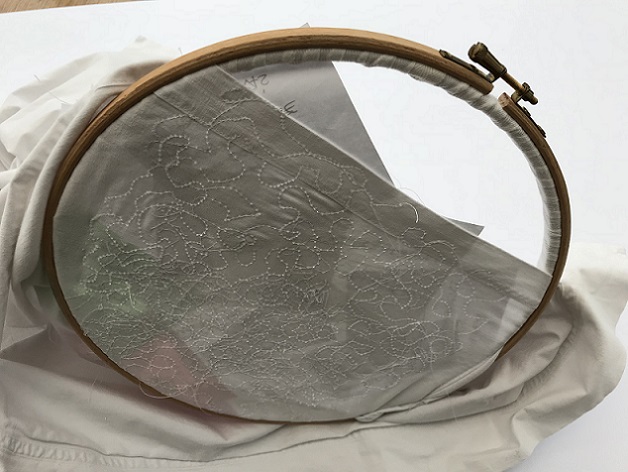
Translucent stitches....
This is a work in progress, so I'm not sure how it will develop. I like being led by the materials. I'm wondering about possibly hanging it, painting it with latex, putting a pillow back inside it.....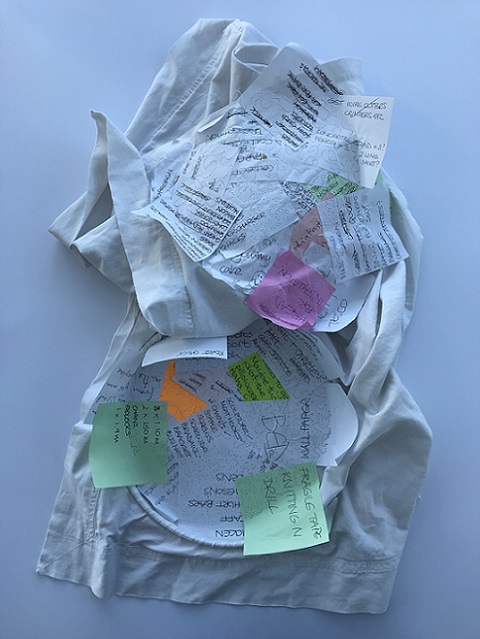
25.1.18
And here are some more images of me tethering my thoughts:
1. Lists galore.
2. It begins! Mesmerising stream of consciousness drawing with stitch, 19.1.18
3. First embroidery hoop of stitching, 19.1.18
4. Reverse of the stitching, inside the pillowcase. Light shines through the pierced cloth and there is a faint trace of the writing showing through, 21.1.18
5. Reverse of the stitching with intentional marks made by loose ends, 21.1.18
6. It continues! 21.1.18
7. 25.1.18
8. Work space, 1.2.18
2017, Pharmacopoeia aka Displacement activity #9: sculpting with pill packets and a stapler

Renamed! Pharmacopoeia, installed at Subversive surfaces exhibition at Town Hall Arts, Trowbridge, May- June 2018
I have been collecting empty pill packets for a while. I’m interested in them for several reasons. I have to regularly take tablets myself so I gather a few a month; if I’m unwell, of course, the pile grows. I have also discovered, through this strange collecting obsession, that a number of dear friends have to take many tablets every day to stay well. It is subsequently very poignant when I receive their latest stash, a bag or bundle of pill packets. I find the actual packets visually interesting, they are the same but different. They change form when the pills are popped out of them, curving as the surface tension changes, already becoming sculptural. It also interests me that I can elevate something that would normally be discarded by incorporating it into art. The ultimate in recycling? I also really like their associations with bodies.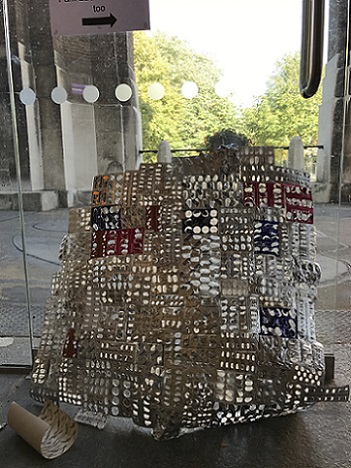
Displacement activity #9: sculpting with pill packets and a stapler
I love the way the light shines through the empty spaces.
In September 2017 I took part in a month-long residency with Synecdoche, [dis]place at The Vestibules in Bristol. Unfortunately, for the previous 6 weeks I had been manically knitting for a deadline and had damaged my wrist, so I couldn’t knit for a while. I was bereft! Instead I embarked on a series of site responsive research projects which I called Displacement activity. Have a look at my Installation and site responsive works for more details.
Sculpting with pill packets and a stapler was Displacement activity #9. I needed to do things that could be easily interrupted as I often had to stop what I was doing to talk to visitors or other artists or sort things out so I took my collection of pill packets…. and a stapler! I started hand stitching the packets together with red thread but soon realised it wasn’t immediate enough so I started stapling them together instead.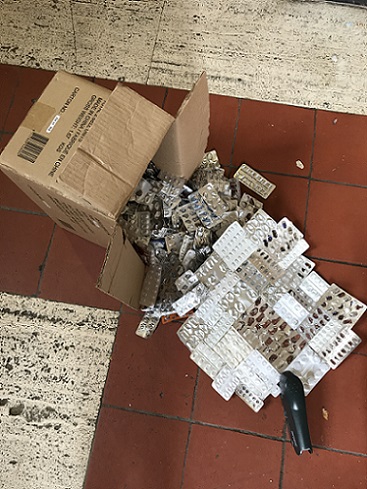
It begins! Day 10 of Synecdoche's [dis]place residency, 18.9.17
I love the idea of a staple being a stitch. I like the gestural nature of stapling, although it was trickier than I originally thought. It’s very cathartic - rhythmic, repetitive and definitely fits my state of flow criteria so meditative too! The process of stapling was like the narrative of someone’s ill health or pain. It feels precarious, like ineffectual mending. It’s like making a patchwork; the whole is greater than the sum of the parts. It becomes something ‘other’. It’s alchemy; the pill packets are transformed through a mundane process. I am making public things that are normally private.
For a snapshot of me stapling pill packets (and the residency generally), have a look at [dis]place finissage 2017, a video by Francis Martin.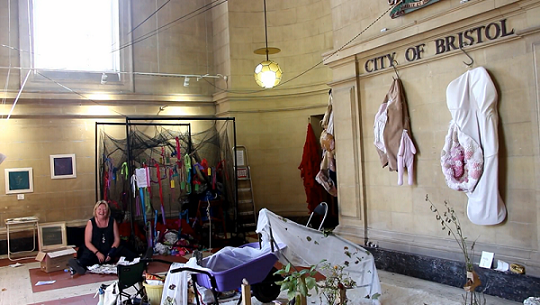
A still of me stapling pill packets from Frances Martin's video [dis]place finissage
I also found it was a talking point for visitors; I had some poignant conversations about dependence on medication and ill health. They are a provocative material – many people were attracted to the finished piece because it sparkled and then were shocked or delighted when they saw what it was made from.
Here are some of the things that people said about it:
‘That’s my life. Right there.’
‘It looks like something else and then you get close and recognise what it’s made of.’
‘Oh! Thanks for reminding me. I need to take my tablet.’
‘It’s like a dalek…. Or a suit of armour.’
‘It makes me think of armour, protection. You could make a jacket.’
It was also a wonderful environment to experiment with hanging and photographing the sculpture that I made. 
Displacement activity #9: Sculpting with pill packets and a stapler
installed at Synecdoche's [dis]place at The Vestibules, Bristol, Day 14, 22.9.17
It’s hard to see this piece as finished, but maybe it is, maybe it isn’t. I still have a growing collection of pill packets and plan to do more with them so time will tell….
Have a look at this gallery of images:
1. A parcel of pill packets from a friend arrives in the post.
2.- 6,. It begins. 18 & 19.9.17
7. & 12. Both sides.
8, 9, 13 - 16, 18 - 29. Trialling different installations
10, 11, 17. The light shines through…
30. A still of me stapling pill packets from Frances Martin’s [dis]place finissage video, September 2017
31,32. Installed as Pharmacopoeia at Subversive surfaces exhibition at Town Hall Arts, Trowbridge, May-June 2018
2015, All the babies I might have had II
1. All the babies I might have had II and Nobody 1, installed at The Knitting and Stitching Show, London, October 2015
2-5. All the babies I might have had II, detail, leather, used clothing, zips; stitch
6. All the babies I might have had II, detail, leather, used clothing, zips; stitch, H106 x W65 x D60cm (Suspended with meat hook and chain)
‘Textiles command an intimate relationship with the body. Our earliest known examples of dress used the skin of animals to cover the skin of people. Critic Anne Hamlyn refers to the textiles we wear as a ‘surrogate skin, a body at one remove’ (Hamlyn, 2000, p42).
As part of my Embroiderers’ Guild Scholarship I have been exploring further the sculptural capabilities of leather and stitch to provoke an abject response. Leather is obviously the closest material to human skin that I can legally use; it is skin! Skin is the boundary between self and other. For All the babies I might have had II I have used a tan nubuck leather hide, which is suede-like and has an interesting rigidity. I have stitched quilted and partly stuffed baby grows, with beanie sections, into the zipped openings.
All the babies I might have had II, detail,
installed at The Knitting and Stitching Show, London, October 2015
I have used baby grows in my work in the past and I know that they are highly emotive; using them to create a piece of work to exhibit at The Knitting and Stitching Shows where the audience is predominantly women of a certain age was a very conscious decision. I want my work to provoke a response and I know that, possibly for women in particular, there are many stories of sorrow around childbirth. This work is based on my own story, but I know it will have a universal resonance.
All the babies I might have had II, detail,
installed at Privy at The Edwardian Cloakrom, Bristol, June 2016
I found my response to working with baby grows intriguing. I couldn’t even consider using the few of my son’s baby clothes that I have kept, so these are anonymous, bought from a charity shop. Does this matter? I feel that it actually adds meaning as these represent an accumulation of all the anonymous babies that have not been born.
Is it too literal? Possibly. But I thoroughly enjoyed the freedom of doing what I felt like doing without the constraints of how my University tutors would respond and without having to justify it. I find a dark humour in cutting up baby grows too. They are obviously not babies, but their presence strongly suggests babies. It reminds me of what Bernadac says of Louise Bourgeois’ use of clothing:
‘A garment is …like a stuffed animal, it is a transitional object that represents a person, suggests a mood or evokes an emotional experience’. (Bernadac, 2004, p 155)
And I have stitched and stuffed them so that they are very baby-like, including beanie sections to give weight and form to the limbs…. 
Attraction or repulsion? A couple of viewers can't resist touching
All the babies I might have had II at Memory of Space, November 2016
Investigating the notion of stitch as tattoo, I have used a range of flesh coloured threads to draw onto the leather using free machine embroidery. The drawings were abstractions from the original photo cut-outs I used for Nobody I, memories of what is left behind when someone leaves. This time, however, I stitched drawings onto every surface, ‘tattooing’ my memories into the leather, and partly concealing them with loose threads, creating a troubling, hairy surface which blurs the boundaries of visual and tactile experience (Bristow 2011: 45).
‘…hair and skin are sometimes treated as culturally and biologically synonymous, while at the same time, paradoxically, hair is treated as other, different, abject, outside the body’ (Tondeur, 2012)
Leaving hanging threads is becoming a recognisable and important part of my work; I consider the loose threads to be a deliberate form of mark making. Their seemingly random placing is an illusion. In this piece, the colour is selected to blend with the colour of the leather so that the stitching becomes almost invisible. The ends are carefully kept from being stitched into, cut to a particular length, and placed at chosen points in the stitching. Sometimes I have added extra loose ends by stopping, cutting, then continuing stitching. Some threads are curled from being wound on the reel which adds an extra dimension of fluidity to the work.
All the babies I might have had II, detail,
installed at The Memory of Space, Centrespace Gallery, Bristol, November 2016
I have fabricated a surface which amplifies ways for the eyes to ‘feel’ the hairiness. There is a merging of the senses of touch and sight associated with cloth; ‘The eye…does not simply look. It also feels. Its response is both visual and tactile…’ the senses are ‘…each enfolded in the other’ (Barnett 1999: 185). This means that cloth can also be regarded as an extension of the body, a second skin. I suggest that the materiality and skin-like nature of cloth provides an alternative range of meanings, operating ‘both through the haptic and the scopic simultaneously, the two modes of perception provide differing points of access to the viewer’ (Dormor 2008: 240). 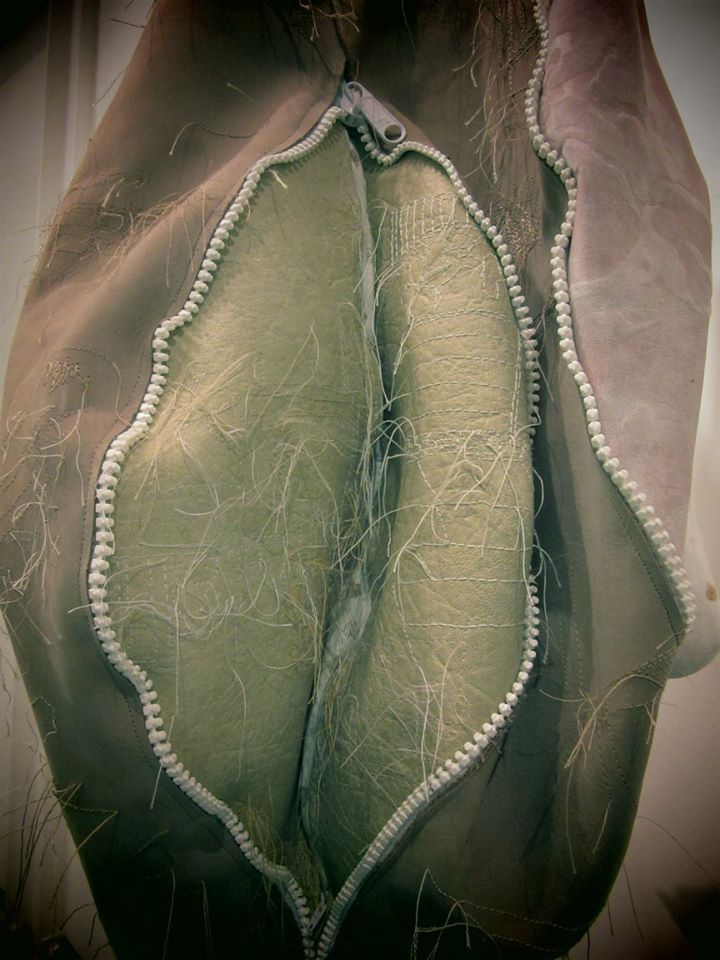
All the babies I might have had II, detail,
installed at Memory of Space at Centrespace Gallery, Bristol, November 2016
I am very conscious of the multiple piercings of the leather as I stitch…and the multiple piercings of my fingers as I work with such a difficult material! As each stitch pierces the leather it echoes the pain of absence, but is also therapeutic, as through the pain comes creativity.
Have a look at the article Memory, the self and the conflicts of modernity by Esther Bancroft on the Epigram website. She critiques this piece as part of a review of the Memory of Space exhibition which took place at Centrespace Gallery, Bristol in November 2016. Unfortunately the images have now disappeared.
Part of Epigram's review of The Memory of Space exhibition
at Centrespace Gallery, Bristol
Look at All the babies I might have had I as well. It's a hand knitted, felted web which is suspended using tension and gravity. It's visually very different to this sculpture but deals with the same theme. I have also written about it in my blog post, All the babies I might have had?
All the babies I might have had I,
installed at Pattern, Fringe Arts Bath, May-June 2016
Select bibliography
Barnett, Pennina, 1999, ‘Folds, fragments and surfaces: towards a poetics of cloth’ in Hemmings, Jessica (ed.), 2012, The Textile Reader, Berg: London, New York pp 182 -190
Bernadac, Marie-Laure, 2004, Louise Bourgeois. Paris, Musée D’art contemporain de Bordeaux
Bristow, Maxine, 2011, ‘Continuity of touch- textile as silent witness’ in Hemmings, Jessica (ed.), 2012, The Textile Reader, Berg: London, New York pp 44 – 51
Dormor, Catherine, 2008, ‘skin: textile: film’ in Textile, Volume 6, Issue 3, pp 238-253
Hamlyn, Anne, 2000, ‘Textures of Memory’, n.paradoxa 6 pp40-43 in Hemmings, Jessica, 2008, ‘Grown fashion: animal, vegetable or plastic’ in Textile, Volume 6, Issue 3, pp262 -273
Prasarn, Numidas, 2012, The Evolution of Fashion as a Signifier, Available from: http://coilhouse.net/2012/11/the-evolution-of-fashion-as-a-signifier/ [Accessed 9 November 2013]
Tondeur, Louise, 2012, ‘Patrolling of the Cultural Borders of the Body: Is Hair a Second Skin?’ in Textile: The Journal of Cloth and Culture, 1 January 2012, vol. 10, no. 3, pp. 262-275(14), [Accessed 30 September 2013]
2015, The Others: a self portrait
1 - 7 Other 1, 2015, imitation leather, hand knitted felt, fake fur, zip; stitch, H137 x W55 x D55cm (Suspended with steel wire)
8 - 12 Other 2, 2015, imitation leather, velvet, zips; stitch, H125 x W65 x D65cm (Suspended with steel wire)
13 -16 Other 3, 2015, imitation leather, felt, zips; stitch, print, H130 x W60 x D60cm (Free standing; hidden stand, concrete base, metal pole)
17-23 Other 4, leather, velvet, knitting, zip;stitch, print, H190 x W65 x D55cm (Free standing; visible concrete base, hidden metal pole)
24 -29 Other 5, leather, knitting,zips; stitch, H137 x W55 x D60cm (Suspended with steel wire)
The Others is a compelling series of 5 soft sculptures which has developed into a form of self-portrait, a reflective and emotive response to the ongoing excavations of my dark side. I have continued to use cloth and stitch to explore notions of loss and the abject. Using soft, impermanent, skin-like textiles in sculpture, with their associations with craft and the feminine, powerfully subverts traditional representations of the body and evokes its mortality, revealing alternative meanings in its folds and surfaces.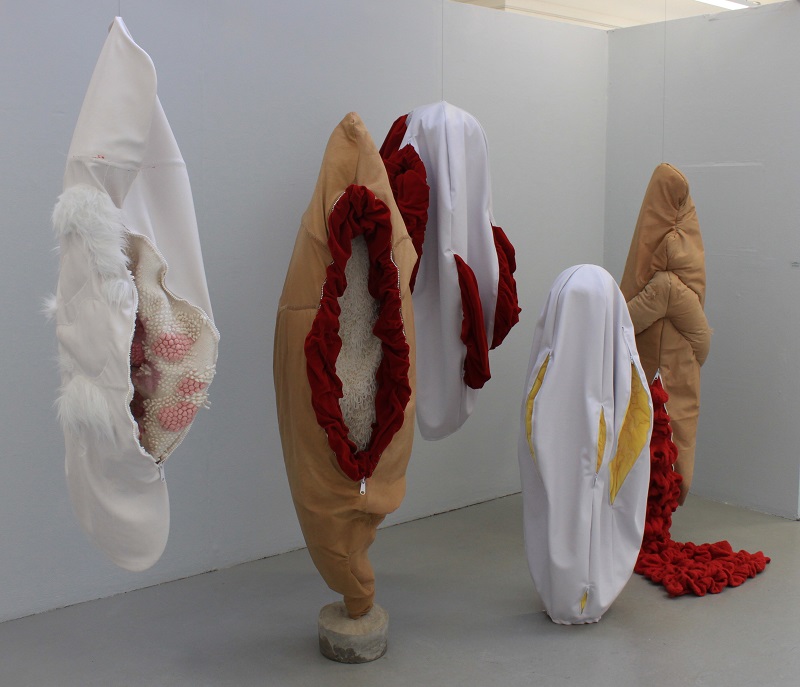
The others; a self portrait, 2015, installed at The Degree Show, UWE, June
Individually, the sculptures are aesthetically pleasing yet troubling; as a series they are imposing, an uncanny bodily presence. I feel that I have successfully produced a disturbing tension between repulsion and attraction through the materials and processes I have chosen and by the careful consideration of similarities and contrasts in form, colour and complex surfaces. This creates a disturbing synthesis between visual and tactile experience.
Other 1, 2015, detail,
imitation leather, fake fur, hand knitted felt, zip; stitch
The focus of this body of work is on individuation, a process which, according to Carl Jung, needs to occur in the second half of life, of finding meaning in life. It is ultimately a preparation for death. Jung talks about balancing our multiple selves with the dark side, or shadow, of ourselves and maintains that failure to acknowledge and accept this shadow can result in fragmentation and associated mental health issues. He also describes the shadow as being the seat of creativity.
Although The Others are included here on my Stitch page, many of them also, obviously feature sculptural knitted sections. Have a look at my Knitting page and my blog post I knit therefore I am for more thoughts about knitting. 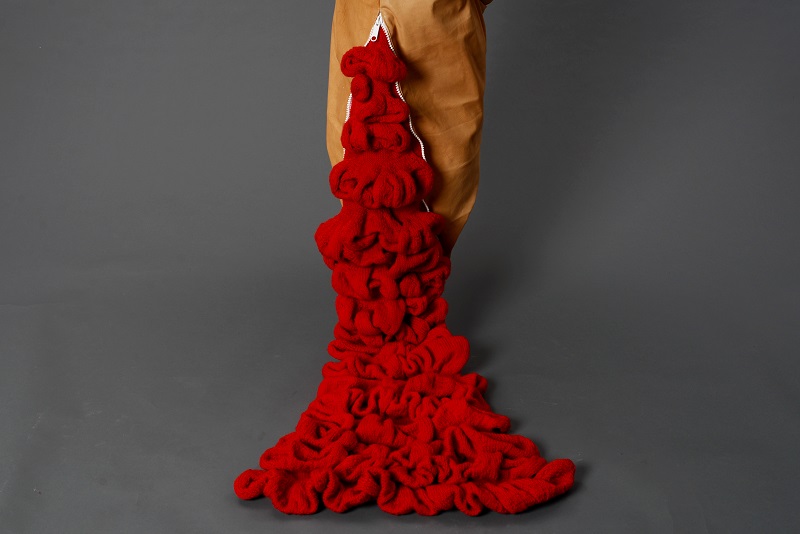
Other 5, 2015, detail, leather, hand knitting, zip; stitch
'They can be whatever you want them to be'. I like to think there is also a playful aspect to my work. That many people see genitalia is one; sculpting my aging body as an assortment of oddly quilted, saggy body bags is another! 
Other 4, 2015,
leather, velvet, hand knitting, concrete, zip
Read more reflections on my use of zips in my blog post, Giant genitalia; in defence of the zip, one year on.
Other 3, 2015, detail, imitation leather, velvet, zips; stitch
Choosing to hang several of the sculptures has increased the sense of the abject and added a spectral quality; considerations of scale, height of hanging and proximity amplify the immersive nature. That the hanging sculptures move randomly without the need for animatronics is a bonus! Ideally, I would like to install a multitude of them in a confined space so that the viewer has to walk amongst them; adding an element of claustrophobia would, I believe, offer a highly disturbing experience in a surreal landscape.
NOTE: In December 2017 I did just this! I installed 11 of my soft sculptures at PRILIC exhibition in a semi derelict swimming pool, Jacobs Wells Baths, in Bristol. It has been a Dance Centre so there is also a wall of mirrors... my soft sculptures became a Multitude!
Read my blog post Cloth and the abject and my Embroiderers' Guild Scholar's report for more thoughts about this work.
I have also worn these sculptures as part of my Wearing the unwearable series. Have a look at my Performance page for more images and details.
Other 5, Wearing the unwearable, 2015
I used my Embroiderers' Guild Scholarship Award to buy the leather for Other 4 and Other 5.
2014, Nobodies
1. & 2. Nobodies, 2014, installed at Synecdoche, Embassy Tea Gallery, London, July 2014
3. & 9. Nobody 1, 2014, imitation leather, leather, velvet, used clothing, zips, hair, acrylic paint, stitch, print; H190 x W70 x D70 cm, 5.5kg approx
4.,5.,6.,& 8. Nobody 1, detail
7. Nobody 1, floor installation
10. Nobody 2, 2014, detail, hand knitted felt, zips, stitch; H175 x W40 x D60cm, 2.9kg approx
11. Nobody 3, 2014, detail, hand knitted wool, knitting needles, H200 (including hanging knitting needles and yarn) x W55 x D55cm, 3.2 kg approx
Nobodies is a series of three soft sculptures, hanging from meat hooks and chains, which explore ways that cloth and stitch can evoke the abject in art. The critical theorist, Julia Kristeva, describes the abject as the instinctive feeling of horror ‘to a threatened breakdown in meaning caused by the loss of the distinction between self and other’. It is that which inherently disturbs conventional identity and cultural concepts. I have researched the ways Christian Boltanski and Louise Bourgeois use empty second-hand clothing in their work to suggest a physical absence and ultimately, death, the most extreme abjection. Choosing to use cloth in sculpture can powerfully subvert traditional representations of the body.
Using a series of photo cut-outs from a photo montage book I made my son for his 18th birthday, the idea of ‘body, no body, nobody’ was born. Each photo has a distinctive cut-out shape, framed with a memory of a place or time. For this project I am examining my responses to my only child leaving home and the impact that has had on my life. I have been exploring ways to communicate the mixture of emotions involved in this transition, in terms of identity and purpose, loss and absence, through the visual language of abjection. What is left behind when someone leaves? Although it describes a personal journey, it will inevitably resonate with others.
It was on the strength of Nobody 1 that I was awarded The Embroiderers' Guild Scholarship for 2015-16. Read more about it in my blog post Cloth and the abject and my Embroiderers' Guild Scholar's report. 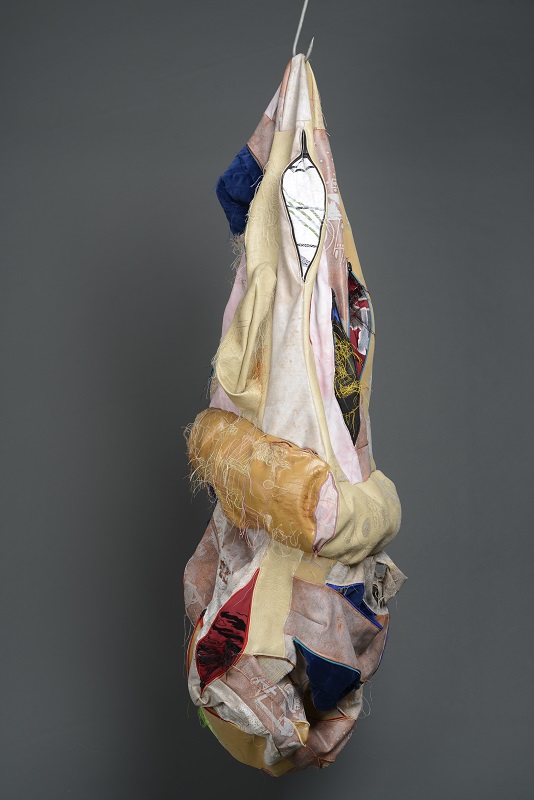
Nobody 1, 2014, leather, imitation leather, used clothing, velvet, hair, zips; stitch, print
Also, Nobody 3 is obviously knitted! Read more about how it became one of the Nobodies on my Knitting page.
Nobody 3, 2014, hand knitted wool, knitting needles


